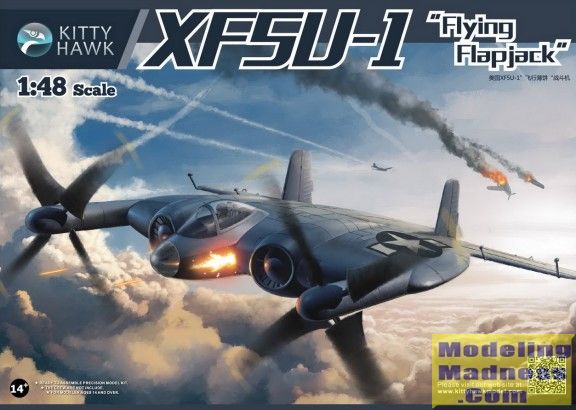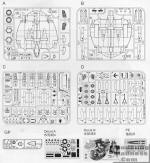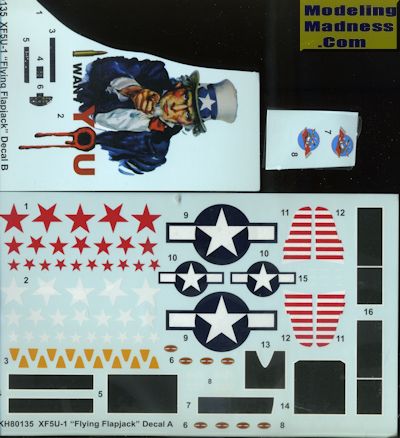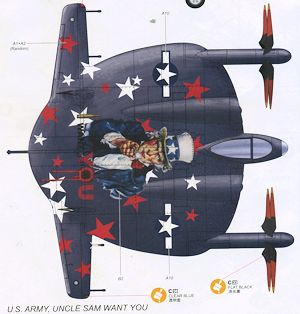
| KIT #: | KH80135 |
| PRICE: | @$45.00 SRP |
| DECALS: | Three options |
| REVIEWER: | Scott Van Aken |
| NOTES: | New tool kit |

| HISTORY |
A developed version of the original V-173 prototype, the XF5U-1 was a larger aircraft. Of all-metal construction, it was almost five times heavier, with two 1,600 hp (1,193 kW) Pratt & Whitney R-2000 radial engines. The configuration was designed to create a low aspect ratio aircraft with low takeoff and landing speeds but high top speed.
Normally, a wing with such a low aspect ratio will suffer from very poor performance due to the degree of induced drag created at the wingtips, as the higher pressure air below spills around the wingtip to the lower-pressure region above. In a conventional aircraft, these wingtip vortices carry a lot of energy with them and hence create drag. The usual approach to reducing these vortices is to build a wing with a high aspect ratio, i.e. one that is long and narrow. However, such wings compromise the maneuverability and roll rate of the aircraft, or present a structural challenge in building them stiff enough. The XF5U attempted to overcome the tip vortex problem using the propellers to actively cancel the drag-causing tip vortices. The propellers are arranged to rotate in the opposite direction to the tip vortices, with the aim of retaining the higher-pressure air below the wing. With this source of drag eliminated, the aircraft would fly with a much smaller wing area, and the small wing would yield high maneuverability with greater structural strength.
The propellers envisioned for the completed fighter — unlike the torque-reducing counter-rotating propellers of the V-173 design — were to have a built-in cyclic movement like a helicopter's main rotor, with a very limited ability to tilt up and down to aid the aircraft in maneuvering. An ejection seat was fitted to allow the pilot to clear the massive propellers in the event of an in-flight emergency. Although the prototype was unarmed, a combination of machine guns and cannons would have been installed under the nose.
The XF5U design was promising: specifications given at the time promised great maneuverability and speeds up to 550 mph (885 km/h). However, it came at the time when the United States Navy was switching from propeller driven to jet propelled aircraft. By 1946, the XF5U-1 project was already long over its expected development time, and well over budget. With jet aircraft coming into service, the Navy finally canceled the project on 17 March 1947, and the prototype aircraft (V-173) was transferred to the Smithsonian Museum for display. Although two aircraft were constructed, a lone XF5U-1 underwent ground runs but never overcame vibration problems. Taxi trials at Vought's Connecticut factory culminated in short "hops" that were not true flights. The only completed XF5U-1 proved to be so structurally solid that it had to be destroyed with a wrecking ball.
| THE KIT |
 When
I heard that this kit was being developed I was immediately interested. In
past years, I had built the rather poor fitting Hasegawa kit and really
liked how it turned out. Rarely do new kits pique my interest as things like
this. It has the combination of looking cool along with being an important
development of the Vought family of aircraft. It makes for an excellent
addition to the 'what if' (whiffer) crowd and in fact, Kitty Hawk has
provided schemes that fill the bill quite nicely. I should mention that
there was supposed to be an anime version but permission to use whatever the
character was to be was denied very late in production so that portion of
the decal sheet was cut away, the pages showing placement were glued shut
and a black sticker put over the view on the side of the box. However, it
still shows in the parts location and those of us who are enamoured with the
subject and can make their own decals will be able to find something
suitable to put in its place.
When
I heard that this kit was being developed I was immediately interested. In
past years, I had built the rather poor fitting Hasegawa kit and really
liked how it turned out. Rarely do new kits pique my interest as things like
this. It has the combination of looking cool along with being an important
development of the Vought family of aircraft. It makes for an excellent
addition to the 'what if' (whiffer) crowd and in fact, Kitty Hawk has
provided schemes that fill the bill quite nicely. I should mention that
there was supposed to be an anime version but permission to use whatever the
character was to be was denied very late in production so that portion of
the decal sheet was cut away, the pages showing placement were glued shut
and a black sticker put over the view on the side of the box. However, it
still shows in the parts location and those of us who are enamoured with the
subject and can make their own decals will be able to find something
suitable to put in its place.
The kit is molded very much like previous Kitty Hawk offerings, though inspection of the parts shows it to be blissfully free of molding glitches such as sink areas or ejector towers. The cockpit is made up of a four piece tub onto which side consoles are added along with a nice seat and there are rudder pedals that attach to the back of the instrument panel. Kitty Hawk provides decals for instruments or you can paint what is there. A small photo etch fret contains a seat harness.
One then builds up the wheel wells which contain a five piece well with the appropriate struts and linkages. Each of the four main wheels is two piece. The tail gear well is a four piece construct and this, along with the cockpit, the two main wells and a pair of engine exhaust are glued to the lower fuselage section. The upper section is then attached along with the bracing behind the cockpit.
Main gear wells have doors with separate hinges, and the tail gear doors have small retraction struts that are attached to them. Also on the underside are a pair of engine covers. I am unsure why these are separate as it seems to me to have been easy enough to mold those in place. The same applies to the upper fuselage. Fins and rudders are separate and slot into the rear fuselage. Intakes have cooling fans directly behind them and there is a small assembly for the nose that consists of a short antenna. Not sure what this is.
The horizontal stabilizers are in three pieces. There is a forward section that contains the formation light and mass balances. Then there is an aft section onto which one then attaches the aileron. Aileron hinges are provided. The prop hub is four pieces on either side with forward halves containing the mounts for the blades and an aft extension piece. The blades then simply slot into the forward section. These should be mounted so they turn outward. I'm not sure why they couldn't have molded the fore and aft tubes as one as the blades do not rotate, though one can position the blades any way one wants when gluing the fore and aft tubes together. This assembly then fits into appropriate areas in the fuselage. Not sure how firm the blade supports are, but I'd install the blades after attaching the mounts. On the 1/72 kit, these easily broke. The last things to attach are the unusual upper fuselage arrestor gear, which is molded in the extended position, then the canopy, which is shown only in the closed position, as well as a pair of bomb racks and bombs. The holes for these racks are pre-drilled and again, I wish Kitty Hawk would leave that option up to the builder.
 The
instructions are well drawn and provide logical construction steps. Color
information is generic with the interior being field green and the wells and
door insides being interior green. When it comes to the overall camo
schemes, there is the box art plane, which is the prototype in overall sea
blue with large upper fuselage walk areas. These walk areas are provided as
decals. All the options have silver landing gear and wheel hubs with white
tail hooks and natural wood prop
The
instructions are well drawn and provide logical construction steps. Color
information is generic with the interior being field green and the wells and
door insides being interior green. When it comes to the overall camo
schemes, there is the box art plane, which is the prototype in overall sea
blue with large upper fuselage walk areas. These walk areas are provided as
decals. All the options have silver landing gear and wheel hubs with white
tail hooks and natural wood prop
 blades
on the outer 2/3rds of the blade with the inner section being black. When it
comes to the whiffer schemes, one is overall silver with red and white
rudder stripes and no upper fuselage walk areas. The really fancy whiffer
option is overall sea blue with the large Uncle Sam on the upper surface
with red and white stars liberally applied over the upper surface. This
scheme also has red and white rudder stripes. The decals are very nicely
printed and if like other Kitty Hawk decals are extremely thin, so care will
be required when applying the larger markings to keep from having issues
with tearing or having them fold
blades
on the outer 2/3rds of the blade with the inner section being black. When it
comes to the whiffer schemes, one is overall silver with red and white
rudder stripes and no upper fuselage walk areas. The really fancy whiffer
option is overall sea blue with the large Uncle Sam on the upper surface
with red and white stars liberally applied over the upper surface. This
scheme also has red and white rudder stripes. The decals are very nicely
printed and if like other Kitty Hawk decals are extremely thin, so care will
be required when applying the larger markings to keep from having issues
with tearing or having them fold
| CONCLUSIONS |
This is one of those kits that get started about as soon as the box is opened. I've always liked this aircraft and from what I've seen, not only will it be a nice build, but I'll bet it sells out quickly once it hits store shelves.
| REFERENCES |
https://en.wikipedia.org/wiki/Vought_XF5U
December 2015
Copyright ModelingMadness.com
Thanks to Kitty Hawk Models and Glen Coleman
for the preview kit. You can find this kit at your favorite hobby shop
or on-line retailer.
If you would like your product reviewed fairly and fairly quickly, please
contact the editor or see other details in the
Note to
Contributors.